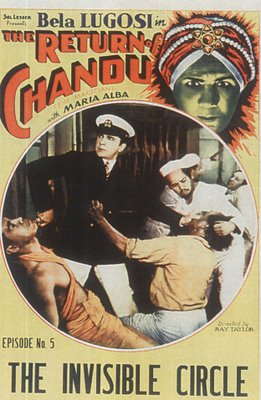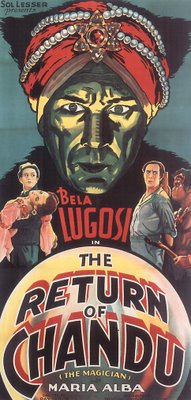

 Lugosi's Heroic Chandu
Lugosi's Heroic ChanduAnyone getting through all twelve chapters of The Return Of Chandu should receive merit badges similar to what Boy Scouts used to award for meritorious service. It is truly a serial for the hardest core among us. A simplistic approach would be to ridicule Chandu with a thousand or so words and move on --- yet there are values here we shouldn’t ignore, for this is no ordinary chapter-play. The Return Of Chandu was seemingly made to languish in an eventual Public Domain. I wonder if it was ever properly copyrighted. Produced by Sol Lesser for an outfit called Principal Pictures, Chandu was released as both a serial and two features. There was even a hybrid version with a full-length story followed by eight weekly chapters. You could thus have Chandu in at least four different menu selections. Being an independent, it kicked around theatres non-stop for twenty or so years after an initial 1934 release, then enjoyed renewed life on stone-age television long before the majors made their feature packages available for broadcast. A lot of fans came by it this way --- sitting cross-legged in front of black-and-white Philcos. Prints were increasingly ragged as negatives wore out and were discarded. Collectors who remembered the glories of Chandu took pains to preserve what remnants were left, though dreadful PD videos made their rounds during the eighties and nineties. VCI’s recent DVD release appears to have originated from a somewhat battered 35mm original, but it will do because it has to do. No one’s likely to initiate (let alone finance) worldwide archival searches for The Return Of Chandu.

 Our main point of interest here is Bela Lugosi. The Return Of Chandu was one time he got to play the hero --- forever in pursuit of miscreants bent on sacrificing his Princess beloved to pagan gods. Serials are usually ying-yang affairs. Some article or person is bandied back and forth between hero and villain for twelve to fifteen chapters. Formula variations are difficult to manage within guidelines so rigid as these. In the case of Chandu, it’s Princess Nadji being carried off time and again. Her to-and-fro between warring camps can be trying, but the real gift Chandu has left us is an opportunity to simply observe Lugosi in settings and circumstances unfamiliar to him --- and us. This is a Bela Lugosi Lifestyle Experience --- not a thing to be underestimated nor taken lightly. Measured pacing, particularly in the first half, allows our man to go about a number of routines parallelling his offscreen life. Conversations are prolonged and relaxed. The camera patiently follows as Bela enters and exits a room. One chapter finds him seated in a waterfront barroom, receiving some message of alleged import. For several priceless minutes, he works with various props that were no doubt part of the actor’s daily routine as well. An ever-present cigar is put aside in favor of a note pad with fountain pen, and for the only time I can recall, we see Lugosi writing in longhand, holding the utensil in a manner I’ve not encountered over all my years observing other's penmanship. Sartorial elegance is maintained by way of crisp white trousers and sport jacket, the occasional turban (always a welcome Lugosi accessory), and a natty yachting outfit topped with an admiral’s cap. Bela radiates confidence here. What a pity it all has to be so ruthlessly snatched away in the second half …
Our main point of interest here is Bela Lugosi. The Return Of Chandu was one time he got to play the hero --- forever in pursuit of miscreants bent on sacrificing his Princess beloved to pagan gods. Serials are usually ying-yang affairs. Some article or person is bandied back and forth between hero and villain for twelve to fifteen chapters. Formula variations are difficult to manage within guidelines so rigid as these. In the case of Chandu, it’s Princess Nadji being carried off time and again. Her to-and-fro between warring camps can be trying, but the real gift Chandu has left us is an opportunity to simply observe Lugosi in settings and circumstances unfamiliar to him --- and us. This is a Bela Lugosi Lifestyle Experience --- not a thing to be underestimated nor taken lightly. Measured pacing, particularly in the first half, allows our man to go about a number of routines parallelling his offscreen life. Conversations are prolonged and relaxed. The camera patiently follows as Bela enters and exits a room. One chapter finds him seated in a waterfront barroom, receiving some message of alleged import. For several priceless minutes, he works with various props that were no doubt part of the actor’s daily routine as well. An ever-present cigar is put aside in favor of a note pad with fountain pen, and for the only time I can recall, we see Lugosi writing in longhand, holding the utensil in a manner I’ve not encountered over all my years observing other's penmanship. Sartorial elegance is maintained by way of crisp white trousers and sport jacket, the occasional turban (always a welcome Lugosi accessory), and a natty yachting outfit topped with an admiral’s cap. Bela radiates confidence here. What a pity it all has to be so ruthlessly snatched away in the second half …

Chapters Seven through Twelve relocate to the Island of Lemuria (a more appropriate name might be the Island of Lugubrious). After their shipwreck, our cast is brought ashore dripping wet to endure another round of abductions and torture. This is where one really feels for Lugosi. He’s obliged to wear the same nasty shirt for the rest of the show, and that’s in addition to some alarmingly strenuous exertions called for by the script. Bela’s co-stars are similarly discomfited. Poor Wilfred Lucas (63) and Clara Kimball Young (44 – looks 64) were silent veterans dating back to Griffith, now overweight and down on their luck as both are manhandled and otherwise shoved about by extras no doubt ignorant of how big they’d once been in nickelodeon days. Lugosi struggles during fistic brawls I wouldn’t have wished on a man twenty years younger, and his apprehension in those dark cave passages is all too convincing. It’s as though Bela's worried the set will suddenly give way and he’ll be plunged into an ignominious Poverty Row abyss. Maybe those labyrinths provided Lugosi a glimpse into his own future, for he’d already taken that plunge, and low-grade product of the Return Of Chandu sort would indeed provide most of the sustenance for those last few decades of his career.



"Educational TV" used to be about the only place where you could see really old movies. They ran silents when no one else would. Sometimes there were documentary programs devoted to genres most people had forgotten. One of these was They Went Thataway (anybody remember it?), a ten-part series produced in 1969/70 about "B" westerns hosted by Jon Tuska, a writer who, among other things, gave us the definitive history of Mascot Pictures. The theme for They Went Thataway was a composition by Nem Harkins (for whom my Google search yielded nothing) called S.O.S. It was just another among hundreds of short musical bursts designed to make a "B" viewer’s heart beat a little faster, but I never forgot that weekly opener. S.O.S. turns up several times in The Return Of Chandu, along with other agitatos like Nervousness and The Menacing Foe. Their composers never took home Oscars, but for anyone who’s watched serials and westerns, these accompaniments have a mesmerizing effect. Maybe it’s the harsh recording, or the primitive arrangements --- much of The Return Of Chandu's music was borrowed from radio or rented through the Abe Meyer Synchronization Service, always at the ready to provide an appropriate theme for producers lacking resources to hire an orchestra. The Kalmus Library was another provider of musical mood to low-budget enterprises. Chandu was one of the very first sound serials to feature near continuous accompaniment. Later Universal and Republics had slicker scores, but few with the raw energy of these cobbled together backgrounds.
Your best bet for quality with The Return Of Chandu is the VCI disc, available HERE. A great place to go for updates on serial releases is In The Balcony (HERE), which features reviews and a discussion group as well. Laughing Gravy is the moderator, and his site is a continuous joy to read.
